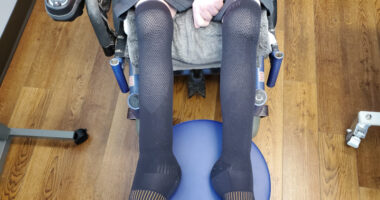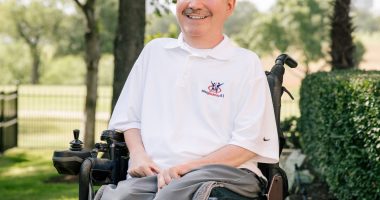Reducing edema prior to range of motion activities
Use of footrests may reduce swelling in feet of SMA patient

Michael Morale and his therapist Emily Jones sit on the physical therapy table working on sitting balance at ClearCut Ortho in Fort Worth, Texas. (Courtesy of Michael Morale)
A common complaint SMA patients have is that their feet swell due to a lack of circulation, as well as being seated in a wheelchair most of the day. In this position, gravity allows for the pooling of fluid in the feet. Since there isn’t much, if any, activation of the lower extremities, the natural muscular pump isn’t available to flush these fluids back into the lymphatic system. Because of the increased swelling, there is reduced mobility allowed in the ankles and feet.
Since my patient with SMA, Michael, doesn’t use feet rests, his feet stay in a plantar-flexed position. This increases the risk of injuring himself in his wheelchair since his feet have no steady support system. We are preparing Michael to be placed in a new wheelchair that has footrests, therefore we are attempting to increase his dorsiflexion to allow for increased comfort in his new chair. With footrests, Michael will be able to maintain increased dorsiflexion which will reduce the amount of edema in his feet. The access to footrests will also improve his safety by reducing the risk of injury by either dragging his feet or getting them hung on an object, such as a rug or door.
In addition to Michael’s lack of range of motion in the muscles and joints, the increased swelling continues to reduce the amount of mobility allowed during passive stretching. To achieve optimal mobility, it is ideal to reduce the amount of edema prior to performing any passive range of motion activity. To reduce edema in the foot and ankle, lymphatic drainage can be performed. This can be performed by applying light strokes, only enough to move the skin. This movement and stroke are very light and not painful. The stroke is performed by starting proximal and working down toward the ankles and toes.
Once the lymphatic drainage is performed and the skin has more extensibility, there will be more mobility allowed to increase dorsiflexion of the ankle. The passive range of motion will be more comfortable for the patient due to the reduced edema in the area. These activities are required weekly for Michael secondary to transferring back into the wheelchair with no foot support after therapy is finished. Once Michael is in his new wheelchair, we will re-evaluate each week prior to performing, to ensure necessity.
Patient perspective
Beginning in junior high, I found it much easier to get my wheelchair under school desks and close enough to doors to be able to open them without the use of footrests. While the doctors warned me about not using footrests, I was 13 years old, and let’s face it, I knew much more than any doctor. Yes, I was stubborn, even as a child.
Fast-forward 44 years later, and let’s just say that I’m suffering the consequences of my poor decisions. Who would have thought the doctors actually knew what they were talking about? Surprise, surprise, surprise!
When I began physical therapy in October 2017, all of my physical therapists were asking the same question: “Why aren’t you wearing footrests?” I explained that it was easier for me to do common everyday tasks without the footrests, but this was an ongoing conversation that we still have nearly six years later. I’ve been working with Emily for more than five years now, and while we get along great, I still get a lecture every once in a while about my footrests.
Sometimes I feel that I’m being scolded, but I know she’s only looking out for my health. I’ve learned over the past five years Emily lectures me about my footrests because she cares about me, so that’s one of the reasons why I’m excited about getting in my new wheelchair. It’s been a long process trying to make all of the adjustments to my new chair, especially finding a cushion that’s comfortable for my hips and legs, along with moving the joystick and other controls in a position that makes it easy for me to reach. Slowly but surely, I’m getting there. My goal is to be in my new wheelchair in the next few months.
When I eventually get in my new chair, my excitement will pale in comparison to Emily’s excitement. Sometimes I feel as if I’m going to do this so that she’ll be excited, but I also realize that I will reap the rewards of doing something good for my body. I’m very thankful that I’ve had physical therapists like Emily who will gently nudge me toward something that will benefit me in the long run. Sometimes I feel like she’s using a baseball bat to nudge me, but hey, that’s why we get along so well.




